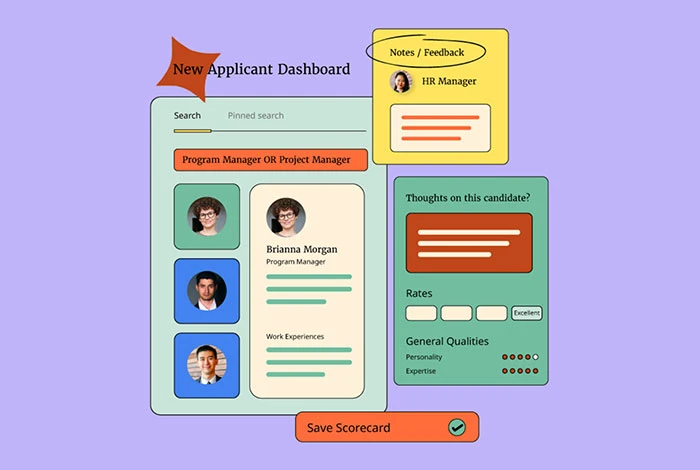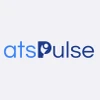Summary: An ATS, or Applicant Tracking System, is a powerful tool that streamlines the recruitment process for employers. We will take a comprehensive understanding of what an ATS is, its benefits, and how it can revolutionize your recruitment process.
Are you tired of spending countless hours sifting through stacks of resumes and conducting endless interviews, only to find out that none of the candidates is the right fit for your company? If so, an Applicant Tracking System (ATS) might just be the solution you’ve been searching for.
According to JobScan, more than 95% of Fortune 500 companies use ATS. Additionally, the study found that 66% of larger and 35% of smaller organizations rely on ATS for their recruitment processes. This data is enough to highlight the widespread adoption of ATS technology across various industries.
In this comprehensive guide, we will talk about what ATS is, how it works, and especially how you can create an ATS-optimized resume to ace your next interview.
What is an ATS?
HR professionals had to deal with hundreds, if not thousands, of resumes daily. To reduce the workload and streamline their hiring process, they started using ATS.
An Applicant Tracking System (ATS) is software that helps manage the entire hiring workflow- from receiving and sorting resumes to scheduling interviews and making job offers. The main purpose of an ATS is to centralize all recruitment-related data in one place, making it easier for recruiters and hiring managers to track and evaluate candidates.
How Applicant Tracking Systems Work?
ATS software works by electronically scanning and sorting resumes based on specific keywords, qualifications, and other criteria set by the employer.
When you submit your resume through an online application portal, it gets parsed and stored in the ATS database. The system then analyzes your resume against the job description to determine if you meet the minimum requirement for further consideration.
For example, if a company is looking for a candidate with strong communication skills, the ATS will search for words like communication, interpersonal, or public speaking in the submitted resumes. If an applicant’s resume includes these keywords, it will be noted as a potential match for the job opening. Next, the application will be forwarded to the hiring manager for further review.
Steps in the ATS Process
There are basically four steps involved in the ATS process.
- The ATS receives a job requisition that contains details about a position, including the job title, desired skills, and necessary experience.
- It generates a profile for the perfect candidate using that information.
- When applicants submit their resumes, ATS analyzes, organizes, and evaluates them based on their compatibility with the profile.
- Subsequently, hiring managers identify the most competent candidates and forward them to the hiring procedure.
Note: Recruiters frequently use key skills and job titles as criteria to filter resumes.
Importance of Relevant Keywords in Your Resume
Keywords are a crucial component of the job search process. By including relevant keywords in their resumes, candidates increase their chances of getting noticed by applicant tracking systems (ATS) and human recruiters alike.
As these keywords act as a filter during the initial screening process, it is essential for applicants to carefully tailor their resumes with the right keywords to demonstrate their suitability for the role.
To identify the right keywords, you can carefully read the job description and look for common terms and phrases used throughout. However, it is important to use these keywords authentically and only if they genuinely reflect your skills and experience.
Note: Optimizing your resume with relevant keywords increases your chances of catching the recruiter’s eye.
Optimizing Your Resume for ATS

Optimizing your resume for ATS (Applicant Tracking Systems) is essential to increase your chances of getting noticed by employers. Here are some tips to ensure your resume is ATS-friendly:
- Use standard resume formats, such as Word or PDF, to maintain compatibility with most ATS systems
- Avoid using images, charts, or graphics that may hinder the ATS software’s ability to read your resume
- Optimize your resume’s formatting using clear headings, bullet points, and standard fonts
- Incorporate relevant keywords strategically throughout your resume
- Tailor your resume for each application to match the specific job requirements
- Use standard section headings like “Work Experience,” “Education,” and “Skills” to help the ATS categorize your information correctly
- Typos and spelling mistakes can harm your chances of passing through an ATS screen, so double-check for errors before submitting your resume
- Stick to a clean, simple layout with standard fonts and avoid using graphics or tables that can confuse the system’s parsing ability
By following these tips, you can increase the likelihood of your resume passing through ATS screening and reaching the hands of hiring managers.
Note: Strategically incorporate relevant keywords throughout your resume to boost its visibility and increase your chances of passing the ATS screening.
ATS vs CRM: Understanding the Difference
While hiring candidates, HRs use two different systems:
- Customer Relationship Management system (CRM), and
- Applicant Tracking System (ATS)
Let’s quickly talk about each of the systems.
ATS, or Applicant Tracking System, helps streamline and automate the recruitment process. It allows HR teams to post job openings, track candidates, manage resumes, and schedule interviews. On the other hand, CRM systems are tools used in recruitment to find and connect with potential candidates who have not yet applied for a job at your company.
CRM solutions offer features like email marketing, scheduling, and communication tools that help build relationships with these candidates. By using a CRM system, recruiters can reach out to potential candidates and establish a connection before they even apply for a job.
Key Features of an Applicant Tracking System
ATS comes with various features that help employers optimize their recruitment efforts. Some of the key features of ATS software include:
- Keyword Scanning: ATS solutions use keyword-matching algorithms to compare the content of job descriptions with resumes. These solutions help identify candidates whose skills and experience closely match the job requirements.
- Resume Parsing: These systems can extract relevant information from resumes and organize it into a standardized format, making it easier for recruiters to review and shortlist candidates.
- Automated Screening: ATS automates the initial screening process by filtering out unqualified candidates based on predefined criteria. This saves recruiters’ time and effort by focusing on qualified applicants.
- Reporting and Analytics: It can generate reports and analytics on various aspects of the hiring process, such as time-to-fill, source effectiveness, diversity metrics, etc. These insights help recruiters measure the success of their recruitment efforts and make data-driven decisions.
- Communication and Collaboration: ATS tools often include communication and collaboration tools, such as email templates, interview scheduling, and candidate messaging features. This streamlines communication between recruiters, hiring managers, and candidates throughout the hiring process.
- Built-in CRM: Some advanced ATS systems include customer relationship management (CRM) modules to manage relationships with potential candidates who may not be actively applying for roles yet.
- Multi-platform sourcing: These tools help recruiters to search for potential candidates through various channels, including job boards, social media platforms, and employee referrals. This expands the reach and potential pool of applicants, making it easier to find qualified candidates.
Note: ATS integration with job boards expands the reach of job postings, attracting a wider pool of applicants.
Accuracy of ATS Software
ATS (Applicant Tracking System) software has gained immense popularity in the hiring process, offering recruiters efficiency and convenience. However, its accuracy is still a question.
A study conducted by Harvard Business Review revealed that a staggering 88 % of recruiters felt that the system disregarded qualified candidates who didn’t perfectly align with the keyword criteria mentioned in the job description.
This heavy reliance on keywords often results in valuable skills, experience, and qualifications of potential candidates being overlooked, causing missed opportunities for both applicants and employers.
Although ATS has its benefits, there is still ample scope for improvement to ensure fair and inclusive hiring practices.
Note: Employers can stand out from the competition by leveraging ATS integrations for fast and effective hiring.
Who Uses ATS?
ATS software is widely used by companies of all sizes and industries to streamline their recruitment processes. From small businesses to large enterprises, ATS software helps HR departments, and hiring managers effectively manage the influx of resumes and job applications. Here are a few of them:
- Recruiters and HR professionals
- Hiring managers
- Small business owners
- Large corporations
- Staffing agencies
ATS software helps manage the influx of resumes and job applications. By automating tasks such as resume parsing, candidate screening, and interview scheduling, ATS solutions save time and resources while ensuring a fair and efficient recruitment process.
Why Employers Use ATS?

ATS helps employers save time and effort in reviewing applications. With the increasing number of applicants for each position, manually sifting through resumes would be an overwhelming task. Businesses can save both time and money by using these automated systems, which streamline the hiring process.
Employers use ATS software because it helps in the following:
- Facilitating seamless communication between hiring managers
- Speeding up the applicant screening process
- Minimizing time wasted on repetitive tasks
- Enhancing the net hiring score
- Boosting candidate engagement
- Gaining a clearer overview of applications
- Simplifying job posting
- Lowering the cost per hire
- Elevating the overall quality of hire
Note: ATS software makes hiring more efficient and expedites it, resulting in time and cost savings for businesses.
The Future of ATS
Artificial intelligence (AI) is revolutionizing applicant tracking systems (ATS) in the ever-changing world of recruitment.
With AI being adept at screening resumes, spotting potential candidates, and even conducting initial interviews, the future promises even more integration. ATS is going to seamlessly merge with social media platforms, such as LinkedIn. It will help identify both active and passive candidates who are a perfect fit for open positions.
Additionally, the introduction of AI-powered chatbots will provide prompt responses and valuable insights throughout the application process. By embracing AI, recruitment is definitely moving to become faster, easier, and incredibly efficient for all parties involved.
Note: Let your ATS do the heavy lifting – automate repetitive tasks to save time and resources.
Creating an ATS-Optimized Resume
To successfully navigate an ATS and secure a job interview, it is crucial to create a well-crafted resume. It takes into account both ATS algorithms and the human recruiters operating the system.
Here is our straightforward guidance on creating an ATS-Optimized resume:
- Customize your resume for each job application to align with the job description.
- Optimize your resume with relevant keywords in both long-form and acronym versions for better searchability. (For example, Use both “Bachelor in Business Administration” and BBA, if possible)
- Go for chronological or hybrid resume formats over functional formats.
- Avoid using tables or columns to prevent parsing errors.
- Choose traditional resume fonts like Georgia, Helvetica, and Garamond.
- Stick to standard resume section headings for clarity and simplicity.
Note: Personalise your resume to include relevant keywords and showcase measurable achievements for an ATS-friendly application.
Disadvantages and Limitations of ATS
While ATS significantly streamlines the hiring process, it’s not a perfect system. Candidates must know its limitations, such as potential false negatives or positives. Below are some of the limitations of ATS software:
- Keyword reliance: ATS systems heavily rely on keywords, which can overlook qualified candidates who may use different terminology.
- Formatting constraints: Complex formatting or creative resumes may not be parsed correctly by the ATS, leading to a loss of visual impact for candidates.
- Bias potential: If not properly calibrated, ATS software might introduce bias based on factors such as gender, race, or education level.
- Inability to evaluate soft skills: ATS systems primarily focus on hard skills and keyword matches, making it challenging to assess a candidate’s soft skills, like interpersonal and communication abilities.
- Technical glitches: Like any software, ATS systems can experience technical issues that result in delayed or mishandled applications.
Key Takeaways
- ATS is a powerful tool used by employers to manage the recruitment process efficiently
- Optimizing your resume with relevant keywords is crucial for passing through ATS screening
- Tailoring your resume for each job application increases your chances of being noticed by ATS and potential employers
- While ATS offers many advantages, it’s essential to be aware of its limitations and adapt accordingly
FAQs Related to Applicant Tracking System (ATS)
What are ATS tools in HR?
ATS tools in HR are software that is designed to automate and streamline the recruitment process. These tools help employers manage job postings, track applicants, screen resumes, schedule interviews, and communicate with candidates.
Is Naukri an ATS?
No, Naukri is not an ATS, it is a job portal that is used by employers and job seekers.
What are the benefits of using ATS?
The benefits of using an ATS include improved efficiency in processing applications, reduced time-to-hire, enhanced candidate experience, centralized candidate data management, enhanced collaboration among hiring teams, and better compliance with hiring regulations.
What is the difference between ATS and a job portal?
ATS focuses solely on managing the recruitment process and tracking applicant data. Job portals are platforms that allow employers to post job openings and connect with potential candidates.
Which ATS does Infosys use?
Infosys uses IBM Kenexa to hire candidates for the job.
Which portal is best for recruitment?
The best portal for recruitment depends on numerous factors like geographic location, industry-specific requirements, company size, and budget. Some popular portals include LinkedIn, Indeed, Naukri, Hire act, Glassdoor etc.
What is the most commonly used ATS?
According to Forbes, some of the most commonly used ATS are Freshteam, JazzHR, Zoho Recruit, Greenhouse etc.
Do all companies use ATS for resumes?
Not all companies use ATS for resumes. While larger organizations often rely on ATS for efficient resume screening and management due to the high volume of applications they receive; smaller companies may still manually review resumes without using an ATS.
Shubham Roy is an experienced writer with a strong Technical and Business background. With over three years of experience as a content writer, he has honed his skills in various domains, including technical writing, business, software, Travel, Food and finance. His passion for creating engaging and informative content... Read more






























